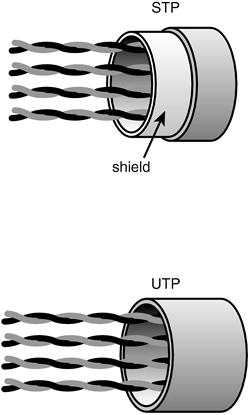The popularity of twisted pair can be attributed to the fact that it is lighter, more flexible, and easier to install than coaxial or fiber-optic cable. It is also cheaper than other media alternatives and can achieve greater speeds than its coaxial competition. These factors make twisted pair the ideal solution for most network environments.
Two main types of twisted-pair cabling are in use today:Unshielded Twisted Pair (UTP) and Shielded Twisted Pair (STP). UTP is significantly more commonplace than STP and is used for most networks. Shielded twisted pair is used in environments in which greater resistance to EMI and attenuation is required. The greater resistance comes at a price, however. The additional shielding, plus the need to ground that shield (which requires special connectors), can significantly add to the cost of a cable installation of STP.
STP provides the extra shielding by using an insulating material that is wrapped around the wires within the cable. This extra protection increases the distances that data signals can travel over STP but also increases the cost of the cabling. Figure 1 shows STP and UTP cabling.
Figure 1 STP and UTP cabling. (Reproduced with permission from Computer Desktop Encyclopedia.� 1981-2005 The Computer Language Company Inc. All rights reserved.)
There are several categories of twisted-pair cabling, with the early categories most commonly associated with voice transmissions. The categories are specified by the Electronics Industries Association/Telecommunications Industries Association (EIA/TIA). Table 1 shows the categories along with the speeds that they are used to support in common network implementations.
|
Category |
Common Application |
|---|---|
|
1 |
Analog voice applications |
|
2 |
1Mbps |
|
3 |
16Mbps |
|
4 |
20Mbps |
|
5 |
100Mbps |
|
5e |
1000Mbps |
|
6 |
1000Mbps + |